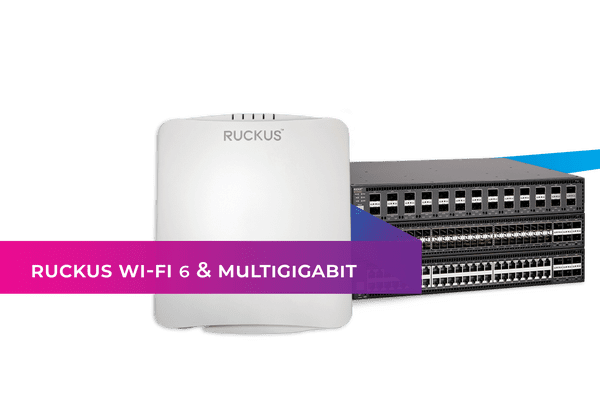25 Mar 2021 RUCKUS Wi-Fi 6 APs with Multigigabit Switches

RUCKUS Wi-Fi 6 Access Points with Multigigabit Switches
ARE YOUR CUSTOMERS GETTING THE MAXIMUM BENEFIT FROM THEIR WI-FI 6 DEPLOYMENTS?
The release of the Wi-Fi 6 standard means that end-users can experience better connectivity of up to 40% faster speeds.
Wi-Fi 6 provides a more immediate data transfer between devices and more devices can be connected on a single access point (AP), resulting in businesses saving on TCO (Total Cost of Ownership) and extending their network’s life for a longer-term.
ARE THE WI-FI 6 ACCESS POINTS DELIVERING THE EXPECTED SPEEDS?
Wi-Fi 6 access points (APs) come with a 2.5 Gbps or 5 Gbps LAN connection. The older Wi-Fi 5 access points (APs) use a 1 Gbps interface, meaning they pair well with standard gigabit switches. However, what if customers are only upgrading their access points and keeping the standard gigabit switches?
In such cases, the network still works, but it results in a huge bottleneck, creating poor workflows and bad end-user experience and therefore not receiving the benefits of Wi-Fi 6. For the best experience, Wi-Fi 6 access points will require compliance with at least the PoE+ standard (802.3at), though some APs will support the legacy PoE standard (802.3af), it will usually reduce the performance of the AP that only multigigabit switches can provide.
WHY DO SOME SWITCHES FAIL TO SUPPORT WI-FI 6 ACCESS POINTS?
More than ever, it is critical to inspect and review the access layer switching to support the leap to Wi-Fi 6 and beyond. Before Wi-Fi 6, there wasn’t a need for greater than 1 Gbps to 2.5 Gbps uplink to the access points. Even in a high-density environment, an access point operating in dual 5 GHZ radio mode will rarely see a throughput of more than 1 Gbps.
What has changed is the enhancement of Wi-Fi 6 features like OFDMA and spatial reuse, creating more efficient and higher throughput rates and enabling more speed and better connectivity. By assembling the correct switches on the network, it will create wider channels, cut out legacy, and run traffic-intensive apps and services with enough bandwidth for heavy applications that end-users can use at ultra-high speeds.
WHAT’S IN THE NETWORK CLOSET?
Most gigabit switches in the networking closet run on 1G speeds, and so a Wi-Fi 6 access point cannot fully function to its capacity with the standard 1G switches, creating a massive bottleneck. However, by adding multigigabit 2.5/5/10 Gbps switches with POE +++ (802.3bt-type 3 power), your customers are guaranteed optimal Wi-Fi 6 performance.
Additionally, running Wi-Fi 6 access points on a gigabit network, the wireless demand exceeds the capacity of their existing Cat 5e or Cat 6 cables to support the demand on the network. Existing gigabit infrastructures cannot handle today’s 9.6 Gbps wireless speeds. It puts more strain on the network infrastructure by using a multigigabit switch with standard NBASE-T (CommScope RUCKUS multigigabit switches). Users can use the same copper cables, Cat 5e and Cat 6 cabling, without upgrading the cabling infrastructure and enjoy the benefits of higher speeds up to 100 meters.
HELP CUSTOMERS REALISE THE POTENTIAL OF WI-FI 6 WITH A MULTIGIGABIT NETWORK
Thinking ahead of the demand that exists today and futureproofing the network with multigigabit switches will create a faster and more efficient working environment and less stressful networking scenarios for the companies. The demand for higher speeds is already here, and it is now only bound to grow more. Get your customers ahead with CommScope RUCKUS WI-FI 6 access points (APs) and RUCKUS ICX multigigabit switches.
Check out some of our RUCKUS blogs:
- Wi-Fi 6 & The Best New Access Points From RUCKUS
- Total Cost of Ownership
- RUCKUS Release Brand New Wi-FI 6 Access Points
- CommScope RUCKUS Introduces ICX 7550 Switches
If you would like further information, please contact us at ruckus@purdi.com
Call us: +44 (0) 1488 647 647